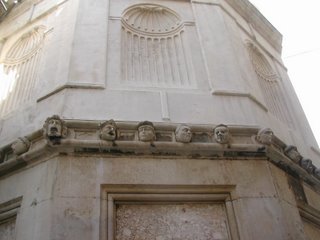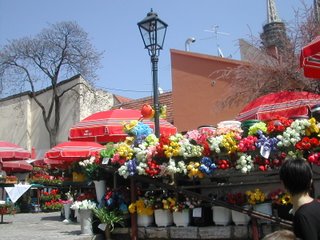
Opatija, on the Istrian Peninsula. This was a favorite of Emperor Franz Joseph, notes a foodie article at www.nytimes.com/2007/05/16/dining/16istri - article by Mark Bittman in the Dining Out section. He is with chef Lidia Bastianich and writes that they arrived at a town "above Opatija, a favorite of Emperor Franz Joseph. It's a town of much faded glory and spectacular hillside views of islands and water."
Agree. Resort. Hospitality, glorious fish - riblji paprikasFirst overnight after landing. Hotels lining the main avenue. Go to the side streets, hillsides, for something more affordable.
Dinner on the water. the waiter brought us, unexpectedly, four perfect little fish, fast fried whole, some kind of breading, on a lettuce leaf with the famous Croatian ajvar, a red sweet-pepper and eggplant puree relish. He said he could tell we were new here, and wanted us to have the best first. A little order of fried sardines arriving unannounced as a courtesy - four of them, perfectly placed on a lovely little plate. Hospitality.
The Istria peninsula, at the north, borders on Italy (Trieste) and Slovenia. Its area runs the gamut from old world to new resort, to dry to port. Find it on the map at www.opatija.net/opatija.asp. We had arrived at the capital, Zagreb, went through Rijeka, and this was our first night in Croatia.
Opatije was in the guidebooks as a fine resort past the bustle of Rijeke. See www.opatija.net/opatija.asp. More hotels and palm trees than we ever expected.
First taste of fabulous Croatian food - many courses, nothing heavy, all fresh. Complete with moon over the water.
Opatije is an old and still elegant resort town, the roads were being torn up and relaid, and parking was jammed on the side streets. One of the hotel clerks where we did not stay (too pricey) kindly came out and edged us out of the steep, now boxed-in parking spot, and actually drove us to another hotel, and even parked our car when I was on the verge of giving up on the tiny space on a vertical hill, huge gully, with the stick shift. He jogged himself back. Need time to get accustomed again to standard shifts. Thank you. More on Opatije: www.croatia.hr/English/TurizamPlus/KongresniCentri/TuristickeRegije.aspx?idDestination=7">Opatije.
If not provided as a courtesy, do buy their little breaded and deep fried and crispy outside perfect little sardines, four in a row on a little curly lettuce. These show too many and far too small (were we eating herring??) but you get the idea: Here are Croatian fried sardines - at www.flickr.com/photos/formfromfunction/120433283/. Go to the home page and only use the rest if you need it for navigating.
Anywhere. Fish. Where else can you sit in early afternoon, in a little tablecloth restaurant, in a small town, somewhere on the coast, headed elsewhere, and find fish heaven. The people at the next table ordered and this is what we saw:
- They order their wine and a platter of clams, a variety.
- During it, in comes an ice cart with 8-9 whole fish and splendid little parslies and herbs, and they took their time, picked their own fish, each something different, and each told the waiter how it was to be prepared.
- More wine. Off goes the ice cart. Continue with the clams, then another hors d'oeuvre, and in comes your very own fish.
Stray from the menu. Ask for the fish cart instead. I did hear that not all the fish is caught locally - so much is shipped out - but it is worth denting your wallet for it.
Try the riblji paprikas - a fish stew, stemming from the Hungarian-Serbian cultures. A soft-cooked sliced onion, at least three kinds of fish, sliced (boneless), water to cover by about 1", bring to boil, add wine and fresh tomato puree or juice (depending on thickness of sauce you want), 4 Tbsp sweet Hungarian paprika, 1/2 -1 Tbsp cayenne (more is better). Simmer 40 minutes. Serve with wide noodles and white wine. Some put the noodles in first in the bowl, then the stew. Frommer's is good on Croatian food.


 Dubrovnik - famous walled city. Also a World Heritage Site. See whc.unesco.org/en/list/95.
Dubrovnik - famous walled city. Also a World Heritage Site. See whc.unesco.org/en/list/95. And regular people living there. Here is some street soccer, seen from the city walls.
And regular people living there. Here is some street soccer, seen from the city walls. Cavtat, Croatia, bay view
Cavtat, Croatia, bay view Sibenik, Cathedral of St. James, Croatia. Adam and Eve.
Sibenik, Cathedral of St. James, Croatia. Adam and Eve. Cathedral of St. James, Sibenik, Croatia. Ring of stone faces.
Cathedral of St. James, Sibenik, Croatia. Ring of stone faces. Flower market, Sibenik, Croatia
Flower market, Sibenik, Croatia

 Nin, Croatia: Parishioner, Easter Morning
Nin, Croatia: Parishioner, Easter Morning Nin, Croatia, bridge
Nin, Croatia, bridge Nin, Croatia: Bishop Gregory, Gregor of Nin
Nin, Croatia: Bishop Gregory, Gregor of Nin Nin, Croatia: Cathedral, St. Cross, claimed as world's smallest
Nin, Croatia: Cathedral, St. Cross, claimed as world's smallest St. Cross Cathedral, Nin, Croatia (world's smallest?)
St. Cross Cathedral, Nin, Croatia (world's smallest?)
 Primosten, Croatia, view
Primosten, Croatia, view Dan Widing at Primosten, scenic view from roadside armchair
Dan Widing at Primosten, scenic view from roadside armchair Wisteria, wall at Trogir, Croatia
Wisteria, wall at Trogir, Croatia
 Korcula, Island, Croatia
Korcula, Island, Croatia Korcula, Croatia: Passageway, laundry
Korcula, Croatia: Passageway, laundry Marco Polo House, Korcula, Croatia (claimed)
Marco Polo House, Korcula, Croatia (claimed)

